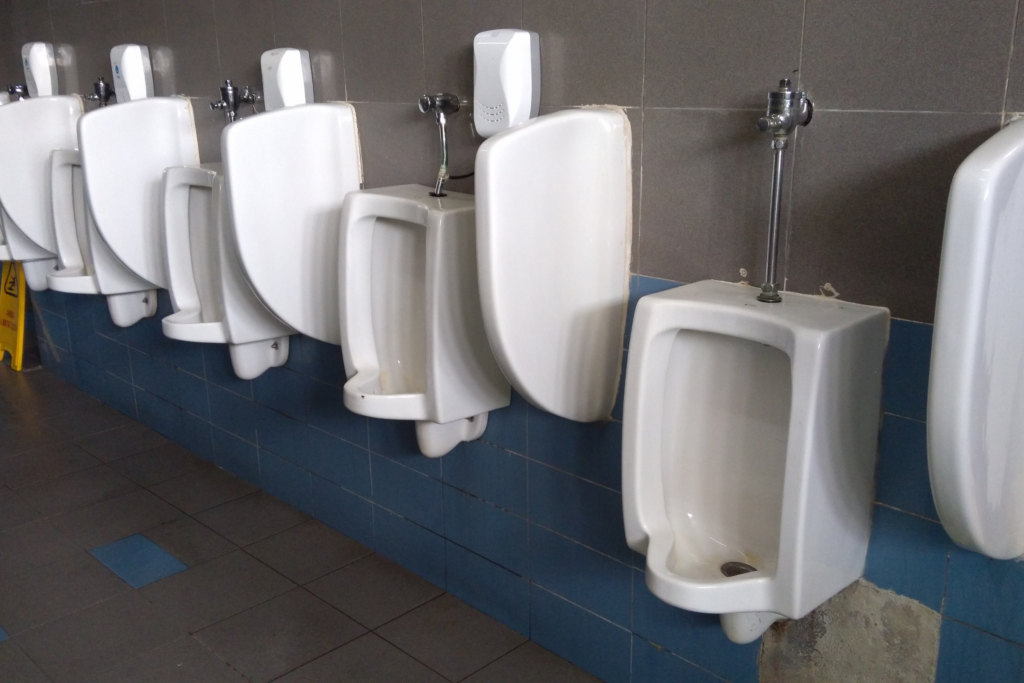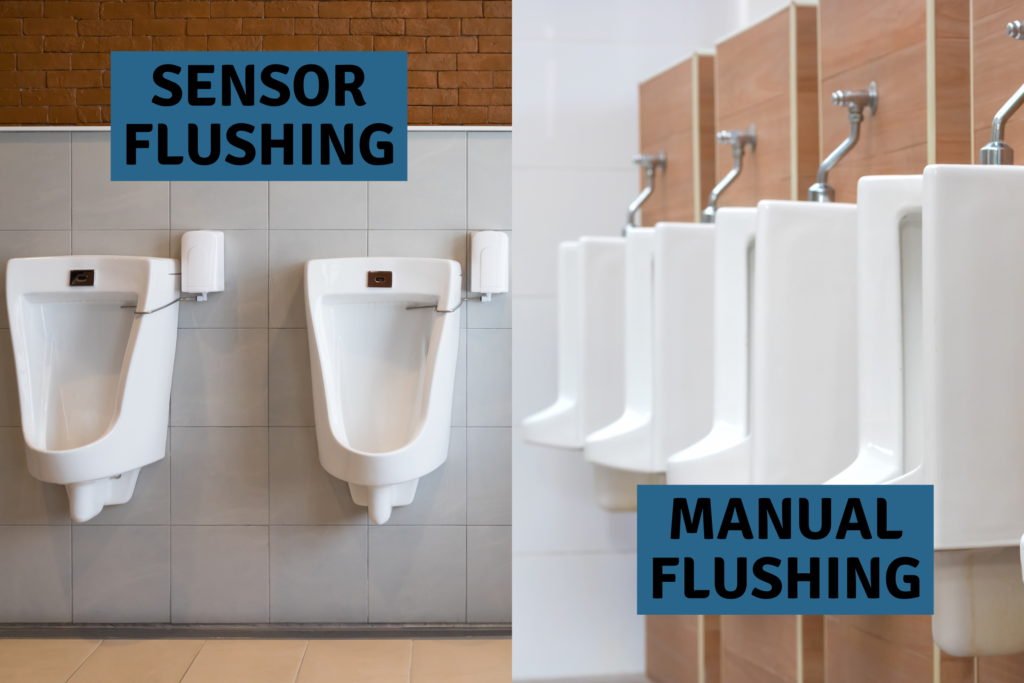Can You Use a Flushometer Valve in Home Toilets? (With 3 Better Alternatives)
Everyone, without exception, has paused at some point in their life to marvel at the incredible power and efficiency of commercial toilets that use a flushometer valve to force water through the toilet on demand. After recovering your senses, you might have wondered if you can use a flushometer valve toilet in your home to take advantage of this design.
Unfortunately, it is not usually practical to install a commercial-style flushometer valve toilet in a home because of their special plumbing requirements and the difficulty involved in upgrading a home’s existing plumbing to work.
Typically, these toilets have two main parts: the toilet bowl and the flushometer valve. The valve eliminates the need for a tank by releasing a metered amount of water directly into the toilet. This efficient single-flush system is designed to help conserve water while still providing a powerful flush.
There are some considerations you should keep in mind, however. In order for a flushometer toilet to work properly, it requires larger-diameter water piping, both from the meter to your house and in the supply piping to the toilet itself. This could potentially make the installation more challenging and costly in a residential setting, where the standard piping is typically too small to accommodate the volume needed for a commercial toilet.
What Is a Flushometer Valve
A flushometer valve is a device used in commercial toilets, primarily in public restrooms, that helps control the flow of flushing water. This section will guide you through its functioning, types, and relevance to home toilets.

How It Works
Flushometer valves operate by using the water pressure in your building instead of relying on gravity like traditional tank toilets. When you activate a flushometer, either by a handle, button, or motion sensor, it releases a metered amount of water into the toilet bowl.
There is no standing water reservoir like in a tank toilet; instead, the flushometer relies on water pressure and valve-open time to flush the fixture properly. This design provides a more efficient use of water, conserving resources and saving money on water bills.
Flushometer vs flush valves – just to clear up any potential confusion I do want to point out that while flush valves exist in home plumbing applications, the flushometer is essentially the commercial version of a basic flush valve
Types of Flushometers
There are two main types of flushometers: manual and sensor-operated.
- Manual Flushometers: These require physical interaction, such as pushing a button or handle, to activate the flush. They are common in public restrooms where constant usage makes simplicity and durability essential.
- Sensor-Operated Flushometers: These utilize infrared technology or other motion sensors to detect when a user is finished and automatically activate the flush. This reduces the need for physical contact, improving hygiene and user experience.

Both types of flushometers are designed to use no more than 1.28 gallons per flush (GPF), which is a 20% savings over the federal standard of 1.6 GPF. This efficiency makes them a suitable option for eco-friendly home toilets as well. However, keep in mind that flushometers require a minimum flush volume of 1.0 GPF to ensure proper functioning and adequate flow in your plumbing system.
While it’s not typical to find flushometer valves in home toilets, their water-saving capabilities and modern appeal can be an attractive choice for homeowners looking to reduce their environmental impact and enhance the aesthetic of their bathrooms.
Benefits of Flushometer Valves for home use
Flushometer-valve toilets are not only used in commercial settings but can also be an efficient option for your home.
Let’s explore some notable benefits:
- Water savings
- WaterSense Certification
- Better Performance & Reliability
Water Savings
One of the main advantages of flushometers is their ability to save water. Unlike traditional toilets with high flush volumes using up to 7 gallons per flush, flushometer-valve toilets are designed to use less water, typically around 1.28 gallons per flush or even lower.
This means that with every flush, you are conserving a significant amount of water and reducing your water usage in the long run.

WaterSense Certification
You can benefit from the WaterSense program by choosing a flushometer-valve toilet. WaterSense, an initiative by the US Environmental Protection Agency, ensures that certified products meet specific performance and water-saving criteria.
Flushometer-valve toilets with the WaterSense label use no more than 1.28 gpf, saving up to 20% more water compared to the federal standard of 1.6 gpf. This means you will not only save water but also have a high-performing and efficient toilet.
Better Performance & Reliability
Flushometer-valve toilets use the force of water pressure to clear waste, as opposed to gravity in traditional flush-valve toilets. This leads to better performance and fewer instances of clogging.
Additionally, flushometers can withstand sudden surges in usage, making them a reliable choice for busy households or parties!
In summary, installing a flushometer-valve toilet in your home can lead to significant water savings, better performance, and a more environmentally friendly household. Keep these benefits in mind when choosing the perfect toilet for your needs.
Compatibility of Flushometer Valves with Residential Plumbing Systems
Like I mentioned before, the biggest obstacle to using one of these commercial valves in your home is the plumbing requirement leading up to the toilet itself.
Let’s take a look at some of these unique needs.
Water Pressure Requirements
Flushometer valves rely on water pressure to function. These valves typically require a water pressure of 25 psi, although they can operate in a range of 10-100 psi.
In order to accommodate a flushometer valve, you may need to ensure that your residential water supply can provide the necessary pressure or can be regulated to do so.
Septic Tank Considerations
If your home operates on a septic system, you may need to verify whether the flushometer valve would be compatible with it. Be sure to check your septic system’s specifications and guidelines to ensure the flushometer valve toilet will work appropriately.
Plumbing Requirements for Wall-Mounted Toilets with Flushometer Valves
Flushometer valve toilets eliminate the need for a tank, but they do require larger-diameter water piping for both service piping (from the meter to the house) and supply piping (to the toilet) in order to function properly and drive enough water through the system during a flush.
To summarize, while flushometer valves and wall-mounted commercial-style toilets can be utilized in residential settings, you need to carefully consider the water pressure, septic tank compatibility, and plumbing requirements before installation.
High-efficiency home toilets – a better alternative to flushometers
Now that we’ve explained what a flushometer valve toilet is and why they are difficult to install in the home, let’s look at the best alternatives.
Keep in mind that each of these alternatives comes with its own pros and cons, and the best choice for your home will ultimately depend on factors such as your budget, local water regulations, and personal preferences. By exploring each of these options, you can find a solution that best suits your needs and contributes to overall water conservation.
Remember, when deciding on a new toilet for your home, make sure to consider efficiency alongside other factors like style and comfort. By doing so, you can find the perfect toilet to fit your space and, at the same time, be mindful of your water consumption.
Dual-Flush Toilets
Probably the most popular alternative to flushometer valve toilets in the home is a dual-flush toilet.
Dual-flush toilets are designed to provide two flushing options, one for liquid waste and the other for solid waste. The liquid waste option uses less water than the solid waste option. Typically, the liquid waste option uses around 0.8 gallons per flush (GPF), while the solid waste option uses around 1.6 GPF. However, the exact amount of water used can vary depending on the specific model of the toilet.
Overall, dual-flush toilets are more water-efficient than traditional toilets and can help to conserve water.

High-efficiency toilets (HET)
High-efficiency toilets (HET) use an average of 1.28 gallons per flush (GPF) or less, which is significantly less than traditional toilets that use 1.6 GPF or more. This makes HETs more water-efficient and environmentally friendly.
Ultra-high-efficiency toilets (UHET)
Ultra-high-efficiency toilets (UHET) use even less water than HETs. They typically use 0.8 gallons per flush (GPF) or less, which is significantly less than both traditional toilets and HETs. This makes UHETs the most water-efficient and environmentally friendly toilets available. However, it’s worth noting that UHETs may have a higher upfront cost than other types of toilets.
How to install a flushometer toilet in your home
When considering the installation of a flushometer valve in your home toilet, it’s crucial to consult with a plumbing engineer. They will help you determine if your home’s water supply system can accommodate the larger-diameter water piping required for a flushometer valve toilet.
By engaging an expert in the field, you will ensure that the installation is done correctly and safely. Additionally, a plumbing engineer can advise you on the appropriate flushometer model to install based on the specific needs of your home.
As for the cost, it will depend on your existing plumbing setup but you should expect to pay hundreds or even thousands of dollars for the complete project.
Common issues with flushometer valve toilets
Flushometer-valve toilets have their own set of unique maintenance requirements.
Here are some essential tips to keep your flushometer toilet functioning optimally:
- To avoid leaks, only use teflon tape when adding the control stop.
- Have a white towel or paper towel handy to catch any water or debris that may spill out from the flushometer during maintenance. This can help you identify the type of debris causing any issues.
- To prevent over-tightening, tighten couplings and covers by hand, and then make snug with a strap wrench or similar tool.
- Regularly inspect your flushometer valve for signs of wear or damage, and replace any worn-out components as needed.
By staying proactive in maintaining your flushometer-valve toilet, you can ensure its reliable, efficient performance for years to come. Remember to consult with your plumbing engineer for any questions or concerns about your flushometer valve’s installation and maintenance.
Popular Flushometer Valve Toilet Brands
When it comes to installing a flushometer valve toilet in your residential space, you have a variety of options to choose from. Some of the popular brands that offer flushometer toilets suitable for home installation are:
- American Standard: This brand is a top choice for many homeowners, thanks to its long-standing reputation for producing high-quality and reliable plumbing fixtures. American Standard offers flushometer valve toilets that are designed for both residential and commercial use, ensuring an efficient and powerful flush every time.
- Niagara Falls: Another hugely popular brand in the world of flushometer valve toilets is Niagara Falls. Known for their innovative and environmentally friendly designs, Niagara Falls has a range of flushometer valve toilets that can help you save water while still providing an effective and powerful flush.
In addition to these brands, there are several other manufacturers that produce flushometer valve toilets.
Some of them include:
- Sloan
- Toto
- Kohler
- Gerber
Before making a decision, it’s important to consider the features and specifications of each brand’s products. A few factors to keep in mind while choosing the perfect flushometer valve toilet for your home include:
- Water Efficiency: Keep an eye out for toilets that use less water per flush, typically 1.6 gallons per flush (gpf) or below. Some modern flushometer toilets even offer high-efficiency options which consume as low as 1.28 gpf.
- Performance: You’ll want a flushometer valve toilet that provides a powerful and consistent flush, ensuring minimal clogging or maintenance issues.
- Compatibility: Ensure that the flushometer valve toilet you choose is compatible with your home plumbing system, such as the water pressure and pipe connections.
By considering these factors and carefully reviewing the flushometer valve toilet offerings of the popular brands mentioned, you’re bound to find the perfect match for your home.
Let Us Know How We’re Doing!
Did this expertly prepared resource answer your question?
Do you have another question about home maintenance, home improvement projects, home appliance repair, or something else?
Get more information, send in questions and keep the discussion going by contacting the I’ll Just Fix It Myself company customer service team at at 1-800-928-1490 or Email us at [email protected]
